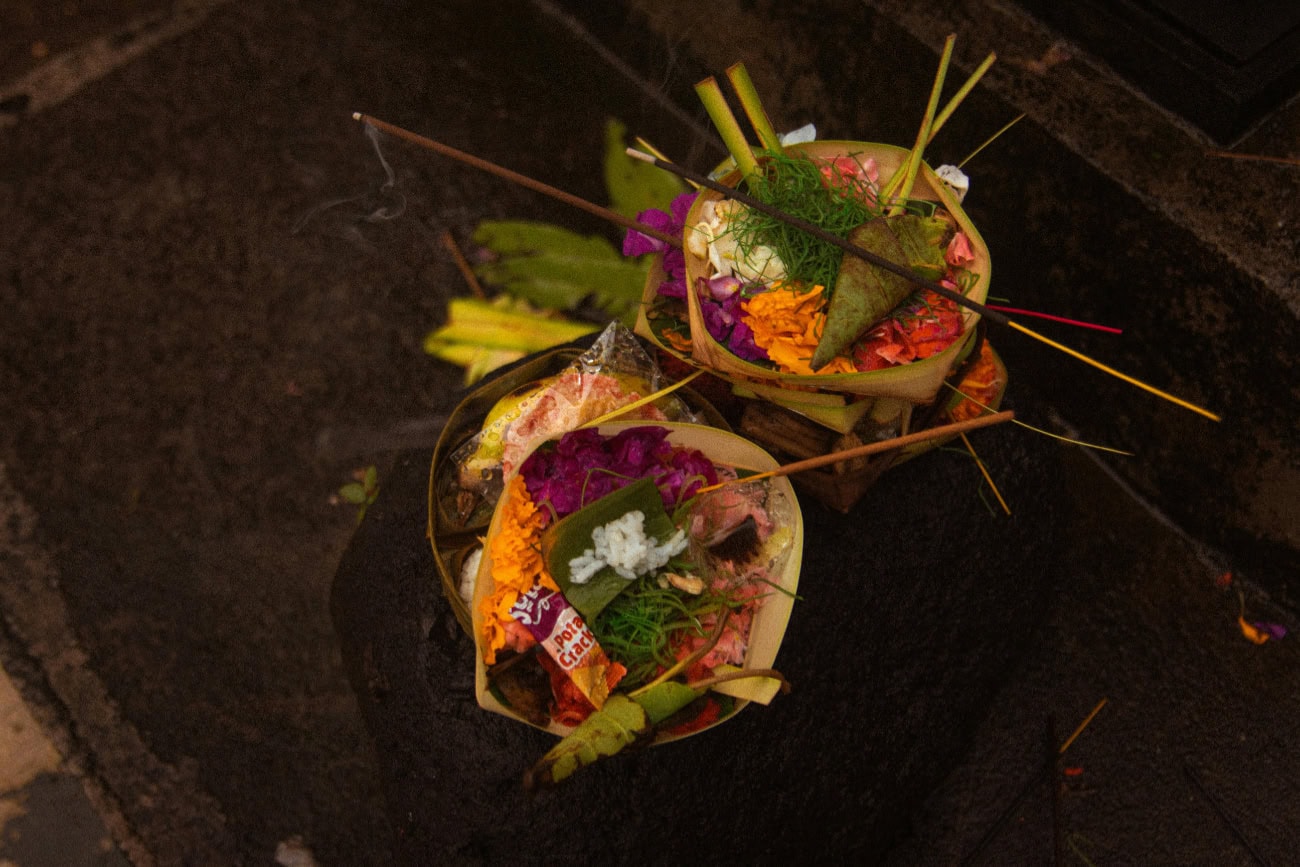One of the most ubiquitous and enchanting sights in Bali is the Canang Sari, small, intricately woven palm-leaf baskets filled with a colorful array of flowers, rice, and other offerings. These humble yet profound offerings are an integral part of daily life for the Balinese Hindu community, serving as a constant reminder of their deep spiritual connection and their philosophy of maintaining balance in the world. Far more than mere decorations, Canang Sari are a beautiful and tangible expression of gratitude, devotion, and the continuous effort to harmonize the seen and unseen realms.
The Meaning Behind the Name
The term Canang Sari itself is rich with meaning. “Canang” is derived from the Old Javanese words “ca” (beautiful) and “nang” (purpose), while “sari” means essence. Thus, Canang Sari can be interpreted as “the essence of purpose” or “beautiful purpose,” reflecting the profound intention and spiritual significance embedded within each offering. They are a daily ritual, a small act of self-sacrifice and thankfulness to Ida Sanghyang Widi Wasa (the Supreme God) and the various deities, as well as a means to appease lower spirits and maintain cosmic equilibrium.
Components and Symbolism
Each Canang Sari is a miniature universe, carefully constructed with specific elements, each carrying symbolic weight:
The Base (Celemik): The small, square or round woven palm-leaf tray forms the foundation of the offering. It represents the Ardha Candra, the half-moon, symbolizing the initial stage of spiritual development.
Flowers: The most visually striking component, flowers are chosen not only for their beauty but also for their color and direction, symbolizing different Hindu deities and aspects of the universe:
- White flowers (e.g., jasmine, frangipani): Placed in the east, symbolizing Iswara (Shiva) and purity.
- Red flowers (e.g., hibiscus, rose): Placed in the south, symbolizing Brahma and creativity.
- Yellow flowers (e.g., marigold, cempaka): Placed in the west, symbolizing Mahadeva (Shiva) and wisdom.
- Blue or green flowers (e.g., canna, pandanus leaves): Placed in the north, symbolizing Vishnu and preservation.
- Mixed flowers: Placed in the center, symbolizing Sang Hyang Widi Wasa and totality.
Lime (Porosan): A small piece of betel leaf, lime paste, and gambier, representing the Hindu trinity (Brahma, Vishnu, Shiva) and the three stages of life (birth, life, death). It signifies sincerity and devotion.
Rice (Wija): Symbolizes the staple food and the source of life, representing gratitude for sustenance.
Snacks and Food (Jajan): Small pieces of traditional cakes, biscuits, or fruit, representing the offerings of earthly pleasures.
Salt (Garam): Symbolizes the purification of the offerings.
Incense (Dupa): The smoke from the burning incense carries the prayers and essence of the offerings to the heavens, purifying the atmosphere and connecting the physical and spiritual realms.
Holy Water (Tirta): Often sprinkled over the offerings, symbolizing purification and blessings.
The meticulous arrangement and selection of these elements are not arbitrary; they are a conscious act of devotion, reflecting the Balinese belief in the interconnectedness of all things and the importance of maintaining harmony with the divine, humanity, and nature (Tri Hita Karana).
A Daily Ritual: Integrating Faith into Life
For the Balinese, making and placing Canang Sari is a daily ritual, often performed multiple times a day by women, though men also participate in larger ceremonies. Before sunrise, the women of the household begin preparing these offerings, a meditative and artistic process that instills a sense of peace and purpose. Once assembled, the offerings are placed in various significant locations:
- On the ground: To appease the lower spirits and demons, ensuring they do not disturb human activities.
- On shrines and altars: To express gratitude and devotion to the gods and ancestors.
- In front of homes and businesses: To invite blessings and ward off negative influences.
- At important crossroads or statues: To honor specific deities or spirits associated with those locations.
The act of placing the Canang Sari is accompanied by a short prayer and a sprinkle of holy water, signifying the purification and dedication of the offering. The smoke from the incense carries the essence of the offering to the heavens, completing the ritual.
Beyond the Aesthetic: The Spiritual Purpose
While their visual appeal is undeniable, the true essence of Canang Sari lies in their spiritual purpose. They are a constant, tangible reminder of the Balinese commitment to their faith and their belief system. They represent:
- Gratitude: A daily expression of thanks for the blessings of life, health, and prosperity.
- Balance: A continuous effort to maintain harmony between the positive and negative forces in the universe, ensuring cosmic equilibrium.
- Self-Sacrifice: The time and effort invested in creating these offerings are a form of selfless devotion.
- Connection: A bridge between the human and divine realms, allowing for communication and interaction with the gods and spirits.
- Purification: The offerings and accompanying rituals are believed to cleanse and purify the environment and the individual.
Respecting the Tradition
For visitors to Bali, observing the Canang Sari is an enriching cultural experience. It is important to remember that these are sacred objects and should be treated with respect. While it is generally acceptable to photograph them, one should avoid stepping on them or disturbing them, especially when they are freshly placed and the incense is still burning. Understanding their significance allows for a deeper appreciation of the Balinese way of life and the profound spirituality that defines the island.
In essence, Canang Sari are more than just pretty offerings; they are the heart and soul of Balinese daily devotion, a beautiful and enduring tradition that reflects the islanders’ deep reverence for life, their gods, and the delicate balance of the universe. They are a small window into the spiritual richness that makes Bali truly unique.
*Canang Photo by Didi Lecatompessy

